Weixiang Zhao
Exploring and Exploiting the Inherent Efficiency within Large Reasoning Models for Self-Guided Efficiency Enhancement
Jun 18, 2025Abstract:Recent advancements in large reasoning models (LRMs) have significantly enhanced language models' capabilities in complex problem-solving by emulating human-like deliberative thinking. However, these models often exhibit overthinking (i.e., the generation of unnecessarily verbose and redundant content), which hinders efficiency and inflates inference cost. In this work, we explore the representational and behavioral origins of this inefficiency, revealing that LRMs inherently possess the capacity for more concise reasoning. Empirical analyses show that correct reasoning paths vary significantly in length, and the shortest correct responses often suffice, indicating untapped efficiency potential. Exploiting these findings, we propose two lightweight methods to enhance LRM efficiency. First, we introduce Efficiency Steering, a training-free activation steering technique that modulates reasoning behavior via a single direction in the model's representation space. Second, we develop Self-Rewarded Efficiency RL, a reinforcement learning framework that dynamically balances task accuracy and brevity by rewarding concise correct solutions. Extensive experiments on seven LRM backbones across multiple mathematical reasoning benchmarks demonstrate that our methods significantly reduce reasoning length while preserving or improving task performance. Our results highlight that reasoning efficiency can be improved by leveraging and guiding the intrinsic capabilities of existing models in a self-guided manner.
On Reasoning Strength Planning in Large Reasoning Models
Jun 10, 2025Abstract:Recent studies empirically reveal that large reasoning models (LRMs) can automatically allocate more reasoning strengths (i.e., the number of reasoning tokens) for harder problems, exhibiting difficulty-awareness for better task performance. While this automatic reasoning strength allocation phenomenon has been widely observed, its underlying mechanism remains largely unexplored. To this end, we provide explanations for this phenomenon from the perspective of model activations. We find evidence that LRMs pre-plan the reasoning strengths in their activations even before generation, with this reasoning strength causally controlled by the magnitude of a pre-allocated directional vector. Specifically, we show that the number of reasoning tokens is predictable solely based on the question activations using linear probes, indicating that LRMs estimate the required reasoning strength in advance. We then uncover that LRMs encode this reasoning strength through a pre-allocated directional vector embedded in the activations of the model, where the vector's magnitude modulates the reasoning strength. Subtracting this vector can lead to reduced reasoning token number and performance, while adding this vector can lead to increased reasoning token number and even improved performance. We further reveal that this direction vector consistently yields positive reasoning length prediction, and it modifies the logits of end-of-reasoning token </think> to affect the reasoning length. Finally, we demonstrate two potential applications of our findings: overthinking behavior detection and enabling efficient reasoning on simple problems. Our work provides new insights into the internal mechanisms of reasoning in LRMs and offers practical tools for controlling their reasoning behaviors. Our code is available at https://github.com/AlphaLab-USTC/LRM-plans-CoT.
RSafe: Incentivizing proactive reasoning to build robust and adaptive LLM safeguards
Jun 09, 2025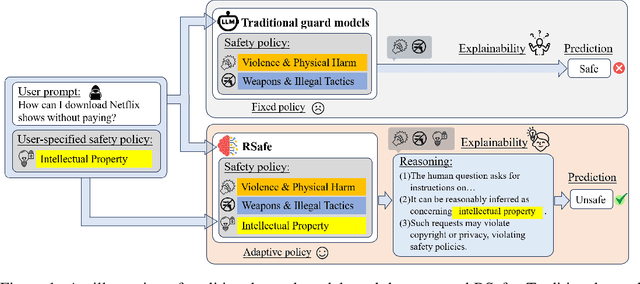
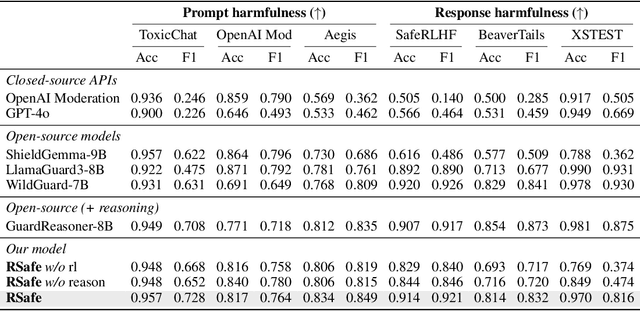
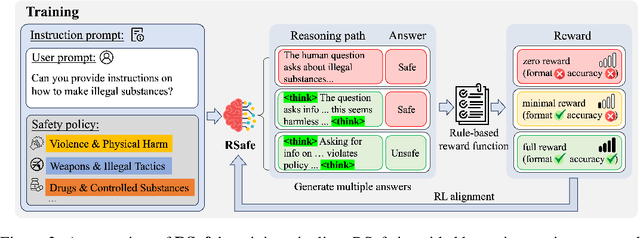

Abstract:Large Language Models (LLMs) continue to exhibit vulnerabilities despite deliberate safety alignment efforts, posing significant risks to users and society. To safeguard against the risk of policy-violating content, system-level moderation via external guard models-designed to monitor LLM inputs and outputs and block potentially harmful content-has emerged as a prevalent mitigation strategy. Existing approaches of training guard models rely heavily on extensive human curated datasets and struggle with out-of-distribution threats, such as emerging harmful categories or jailbreak attacks. To address these limitations, we propose RSafe, an adaptive reasoning-based safeguard that conducts guided safety reasoning to provide robust protection within the scope of specified safety policies. RSafe operates in two stages: 1) guided reasoning, where it analyzes safety risks of input content through policy-guided step-by-step reasoning, and 2) reinforced alignment, where rule-based RL optimizes its reasoning paths to align with accurate safety prediction. This two-stage training paradigm enables RSafe to internalize safety principles to generalize safety protection capability over unseen or adversarial safety violation scenarios. During inference, RSafe accepts user-specified safety policies to provide enhanced safeguards tailored to specific safety requirements.
AlphaSteer: Learning Refusal Steering with Principled Null-Space Constraint
Jun 08, 2025



Abstract:As LLMs are increasingly deployed in real-world applications, ensuring their ability to refuse malicious prompts, especially jailbreak attacks, is essential for safe and reliable use. Recently, activation steering has emerged as an effective approach for enhancing LLM safety by adding a refusal direction vector to internal activations of LLMs during inference, which will further induce the refusal behaviors of LLMs. However, indiscriminately applying activation steering fundamentally suffers from the trade-off between safety and utility, since the same steering vector can also lead to over-refusal and degraded performance on benign prompts. Although prior efforts, such as vector calibration and conditional steering, have attempted to mitigate this trade-off, their lack of theoretical grounding limits their robustness and effectiveness. To better address the trade-off between safety and utility, we present a theoretically grounded and empirically effective activation steering method called AlphaSteer. Specifically, it considers activation steering as a learnable process with two principled learning objectives: utility preservation and safety enhancement. For utility preservation, it learns to construct a nearly zero vector for steering benign data, with the null-space constraints. For safety enhancement, it learns to construct a refusal direction vector for steering malicious data, with the help of linear regression. Experiments across multiple jailbreak attacks and utility benchmarks demonstrate the effectiveness of AlphaSteer, which significantly improves the safety of LLMs without compromising general capabilities. Our codes are available at https://github.com/AlphaLab-USTC/AlphaSteer.
L-MTP: Leap Multi-Token Prediction Beyond Adjacent Context for Large Language Models
May 23, 2025Abstract:Large language models (LLMs) have achieved notable progress. Despite their success, next-token prediction (NTP), the dominant method for LLM training and inference, is constrained in both contextual coverage and inference efficiency due to its inherently sequential process. To overcome these challenges, we propose leap multi-token prediction~(L-MTP), an innovative token prediction method that extends the capabilities of multi-token prediction (MTP) by introducing a leap-based mechanism. Unlike conventional MTP, which generates multiple tokens at adjacent positions, L-MTP strategically skips over intermediate tokens, predicting non-sequential ones in a single forward pass. This structured leap not only enhances the model's ability to capture long-range dependencies but also enables a decoding strategy specially optimized for non-sequential leap token generation, effectively accelerating inference. We theoretically demonstrate the benefit of L-MTP in improving inference efficiency. Experiments across diverse benchmarks validate its merit in boosting both LLM performance and inference speed. The source code will be publicly available.
MPO: Multilingual Safety Alignment via Reward Gap Optimization
May 22, 2025Abstract:Large language models (LLMs) have become increasingly central to AI applications worldwide, necessitating robust multilingual safety alignment to ensure secure deployment across diverse linguistic contexts. Existing preference learning methods for safety alignment, such as RLHF and DPO, are primarily monolingual and struggle with noisy multilingual data. To address these limitations, we introduce Multilingual reward gaP Optimization (MPO), a novel approach that leverages the well-aligned safety capabilities of the dominant language (English) to improve safety alignment across multiple languages. MPO directly minimizes the reward gap difference between the dominant language and target languages, effectively transferring safety capabilities while preserving the original strengths of the dominant language. Extensive experiments on three LLMs, LLaMA-3.1, Gemma-2 and Qwen2.5, validate MPO's efficacy in multilingual safety alignment without degrading general multilingual utility.
When Less Language is More: Language-Reasoning Disentanglement Makes LLMs Better Multilingual Reasoners
May 21, 2025Abstract:Multilingual reasoning remains a significant challenge for large language models (LLMs), with performance disproportionately favoring high-resource languages. Drawing inspiration from cognitive neuroscience, which suggests that human reasoning functions largely independently of language processing, we hypothesize that LLMs similarly encode reasoning and language as separable components that can be disentangled to enhance multilingual reasoning. To evaluate this, we perform a causal intervention by ablating language-specific representations at inference time. Experiments on 10 open-source LLMs spanning 11 typologically diverse languages show that this language-specific ablation consistently boosts multilingual reasoning performance. Layer-wise analyses further confirm that language and reasoning representations can be effectively decoupled throughout the model, yielding improved multilingual reasoning capabilities, while preserving top-layer language features remains essential for maintaining linguistic fidelity. Compared to post-training such as supervised fine-tuning or reinforcement learning, our training-free ablation achieves comparable or superior results with minimal computational overhead. These findings shed light on the internal mechanisms underlying multilingual reasoning in LLMs and suggest a lightweight and interpretable strategy for improving cross-lingual generalization.
Teaching Language Models to Evolve with Users: Dynamic Profile Modeling for Personalized Alignment
May 21, 2025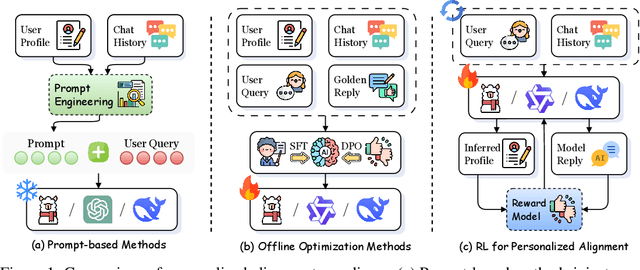
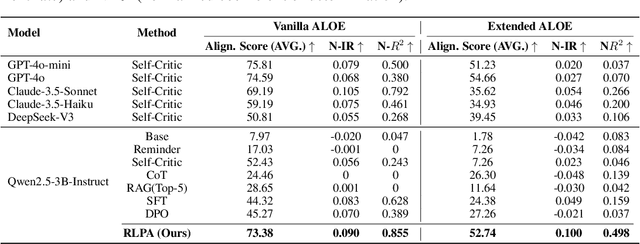
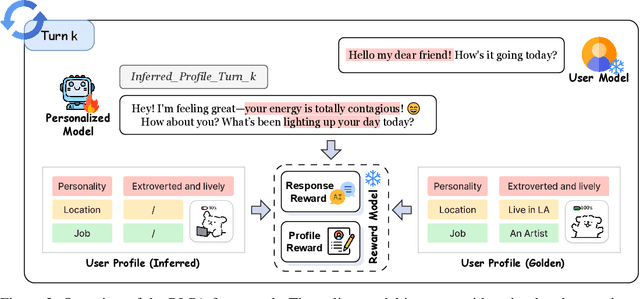

Abstract:Personalized alignment is essential for enabling large language models (LLMs) to engage effectively in user-centric dialogue. While recent prompt-based and offline optimization methods offer preliminary solutions, they fall short in cold-start scenarios and long-term personalization due to their inherently static and shallow designs. In this work, we introduce the Reinforcement Learning for Personalized Alignment (RLPA) framework, in which an LLM interacts with a simulated user model to iteratively infer and refine user profiles through dialogue. The training process is guided by a dual-level reward structure: the Profile Reward encourages accurate construction of user representations, while the Response Reward incentivizes generation of responses consistent with the inferred profile. We instantiate RLPA by fine-tuning Qwen-2.5-3B-Instruct, resulting in Qwen-RLPA, which achieves state-of-the-art performance in personalized dialogue. Empirical evaluations demonstrate that Qwen-RLPA consistently outperforms prompting and offline fine-tuning baselines, and even surpasses advanced commercial models such as Claude-3.5 and GPT-4o. Further analysis highlights Qwen-RLPA's robustness in reconciling conflicting user preferences, sustaining long-term personalization and delivering more efficient inference compared to recent reasoning-focused LLMs. These results emphasize the potential of dynamic profile inference as a more effective paradigm for building personalized dialogue systems.
AdaSteer: Your Aligned LLM is Inherently an Adaptive Jailbreak Defender
Apr 13, 2025Abstract:Despite extensive efforts in safety alignment, large language models (LLMs) remain vulnerable to jailbreak attacks. Activation steering offers a training-free defense method but relies on fixed steering coefficients, resulting in suboptimal protection and increased false rejections of benign inputs. To address this, we propose AdaSteer, an adaptive activation steering method that dynamically adjusts model behavior based on input characteristics. We identify two key properties: Rejection Law (R-Law), which shows that stronger steering is needed for jailbreak inputs opposing the rejection direction, and Harmfulness Law (H-Law), which differentiates adversarial and benign inputs. AdaSteer steers input representations along both the Rejection Direction (RD) and Harmfulness Direction (HD), with adaptive coefficients learned via logistic regression, ensuring robust jailbreak defense while preserving benign input handling. Experiments on LLaMA-3.1, Gemma-2, and Qwen2.5 show that AdaSteer outperforms baseline methods across multiple jailbreak attacks with minimal impact on utility. Our results highlight the potential of interpretable model internals for real-time, flexible safety enforcement in LLMs.
Chain of Strategy Optimization Makes Large Language Models Better Emotional Supporter
Mar 07, 2025Abstract:The growing emotional stress in modern society has increased the demand for Emotional Support Conversations (ESC). While Large Language Models (LLMs) show promise for ESC, they face two key challenges: (1) low strategy selection accuracy, and (2) preference bias, limiting their adaptability to emotional needs of users. Existing supervised fine-tuning (SFT) struggles to address these issues, as it rigidly trains models on single gold-standard responses without modeling nuanced strategy trade-offs. To overcome these limitations, we propose Chain-of-Strategy Optimization (CSO), a novel approach that optimizes strategy selection preferences at each dialogue turn. We first leverage Monte Carlo Tree Search to construct ESC-Pro, a high-quality preference dataset with turn-level strategy-response pairs. Training on ESC-Pro with CSO improves both strategy accuracy and bias mitigation, enabling LLMs to generate more empathetic and contextually appropriate responses. Experiments on LLaMA-3.1-8B, Gemma-2-9B, and Qwen2.5-7B demonstrate that CSO outperforms standard SFT, highlighting the efficacy of fine-grained, turn-level preference modeling in ESC.
 Add to Chrome
Add to Chrome Add to Firefox
Add to Firefox Add to Edge
Add to Edge